Turning is a method of cutting a workpiece on a lathe using the rotation of the workpiece relative to the tool. Turning is the most basic and standard cutting method. Most workpieces with revolving surfaces can be processed by turning techniques, such as inner and outer cylindrical surfaces, inner and outer conical surfaces, end faces, grooves, threads, and rotary forming surfaces.
Due to the development of modern science and technology, various high-strength and high-hardness engineering materials are increasingly used, and traditional turning technology is difficult or impossible to process some high-strength and high-hardness materials. However, CNC turning is often competent and achieves obvious benefits in production.
What are the characteristics of the CNC milling process?
- Flexible and universal: CNC milling machines and machining centers are suitable for the processing of workpieces of various structures and shapes and can complete drilling, boring, reaming, plane milling, bevel milling, slot milling, surface milling (cam), tapping, etc.
- High machining accuracy: CNC milling machines and centers have high machining accuracy, which can generally ensure workpiece accuracy. In addition, CNC machining also avoids operator mistakes, and the same batch of processed parts has good dimensional consistency, which significantly improves product quality.
- High production efficiency: CNC machines and machining centers have the functions of milling machines, boring machines, and drilling machines, making the process highly concentrated, significantly improving production efficiency, and reducing workpiece clamping errors. The spindle speed of the CNC milling machine is infinitely variable, which is conducive to selecting the best cutting amount. The CNC milling machine has fast forward, fast backward, and fast positioning functions, which can significantly reduce the maneuvering time.
- It can process complex shapes: in addition to milling the surfaces of various parts that ordinary milling machines can mill, it can also mill plane curve contours and space surface contours that normal milling machines cannot mill,this is because CNC machine tools have multiple feed coordinates.
- Reduce the operator’s labor intensity: CNC milling machine automatically completes the processing of parts according to the pre-programmed processing program. The operator does not need to perform heavy repetition except for operating the keyboard, loading and unloading tools, workpieces, and intermediate measurements, and observing the operation of the machine tool. The manual process dramatically reduces the labor intensity.
What kind of parts is suitable for machining on CNC lathes?
- Demanding Rotary Parts
The requirements mentioned here include accuracy requirements and surface roughness requirements. Since CNC lathes are far superior to ordinary lathes in manufacturing and tool setting accuracy, compensation accuracy, and machine rigidity, it is necessary to process parts with high precision requirements on CNC lathes. This is especially true for parts with high requirements on the straightness, roundness, and cylindricity of the busbar because the turning motion of the CNC lathe adopts high-precision interpolation and servo drive, which can reasonably achieve the machining accuracy.
The CNC lathe has good rigidity and manufacturing accuracy, and the constancy of cutting speed is excellent, which is very helpful in reducing the surface roughness of the workpiece. Ordinary lathes cannot maintain a constant rotational speed, resulting in inconsistent end surface roughness. With a CNC lathe, the turning rate remains constant at the optimum line speed, so the machined part is not only low in roughness but also consistent.
There are also some ultra-precision and ultra-low surface roughness parts, such as multi-faceted reflectors of laser printers, drums of copiers, lenses, and molds of optical equipment such as cameras, etc., which can only be processed on CNC lathes.
- Parts of revolution with complex surface shapes
Ordinary lathes cannot process the rotating body parts with complex surface shapes. But it’s easy to machine out on a CNC lathe because CNC lathes have linear and circular interpolation functions and some non-circular curve interpolation functions.
The linear and angle interpolation functions can be directly used for processing the parts whose contour curve is composed of straight lines and arcs. For the part whose contour curve is formed of a non-circular curve, the non-circular curve interpolation function can be used to process it. If the part curve is not in the interpolation function of the machine tool, it can also be approximated by a straight line or circular arc. Then the linear or circular interpolation function can be used to achieve the shape required by the drawing.
- Parts of Rotation with Transverse Machining
Some rotary parts have transverse machinings, such as keyways or radial holes, or have a distributed hole system on the end face and a disk sleeve or shaft parts with a curved surface. If ordinary lathes process such details, the number of processes is large, and the methods are relatively scattered, which is unfavorable for processing. However, the turning machining center is used for processing. Due to the automatic tool changing system, only one clamping can complete the multi-processing procedures of the standard machine tool. In this way, the number of clampings is significantly reduced, the principle of process concentration is realized, the stability of the processing quality is ensured, the processing efficiency is improved, and the processing cost is reduced.
- Parts with special threads
In terms of thread processing capability, ordinary lathes can process equidistant straight-face threads and tapered threads, but they are powerless for unequal-spaced and end-face threads. Moreover, a standard machine tool can only process several fixed pitches.
Using a CNC lathe not only can process straight, tapered, and end face threads with an equal pitch but also variable pitch threads such as increased pitch and reduced pitch, as well as threads with equal pitch and smooth transition.
When CNC lathes process threads, the rotation of the spindle does not need to be changed alternately like ordinary lathes, and with machine-clamped carbide thread turning tools, higher speeds can be used, so the processing efficiency is much higher than that of common lathes, and Threads processed by CNC lathes are also of higher quality.







